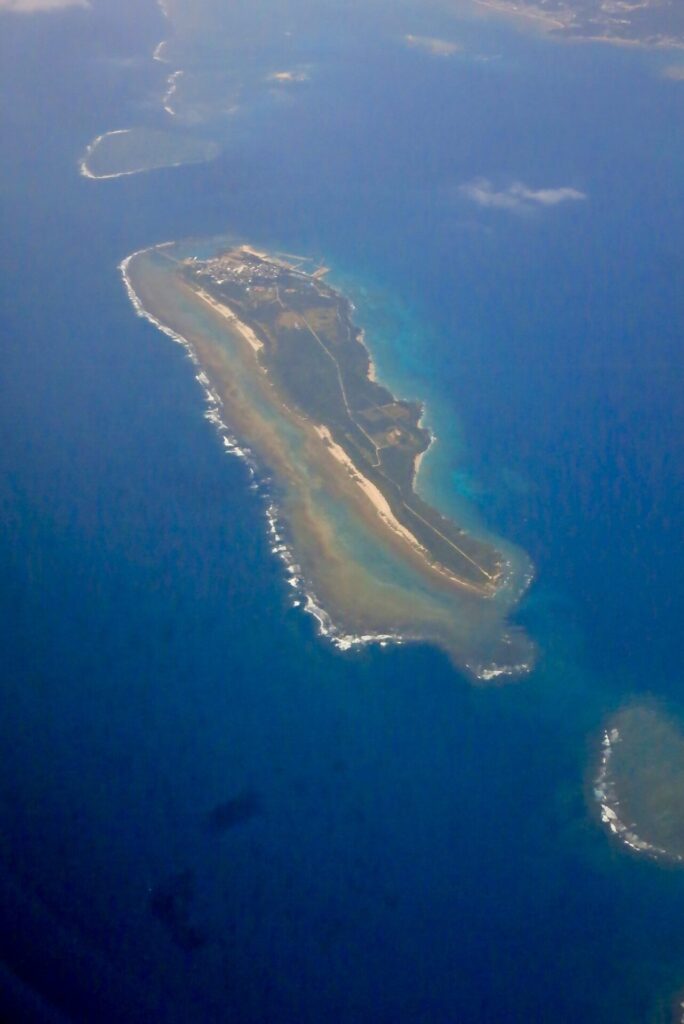Kudaka Island

An island situated 6 km to the east of the Chinen Peninsula in the southern part of Okinawa Island. With a perimeter of 8 km, it stretches out thin and long from south to north, and goes up to 17.1 m at its highest altitude; a flat and low little island made of Ryukyu limestone, bare of any running rivers. Although it had been an island deficient in water, submarine supplies are conducted from the main island of Okinawa in recent years and waterworks have been set for every household.
It has over 100 households and a population of 238 (data of April 2020). Fishery and farming are its main occupations: since ancient times, the fishery was traditionally considered for men, farming for women and to this day, farming is mainly taken charge of by women for subsistence. The farmland is a common property of the island, distributed to each individual over a certain age—a traditional system of allotment known as Jiwari-sei. The community is located in the south, while most of the farmlands are in the north.
As for transportation, a ferry goes to and fro 4 times a day, departing from Baten harbor in Sashiki. The journey takes a little under an hour (article written in 1998)1.
There is a school on the island where elementary and middle school are combined. For your reference, the total number of its students was 11 in 19982. In recent days, some young people came back to the island to work in the fishery—however, in most cases, they leave the island when entering high school and search for employment elsewhere, never returning to the island. Hence, the depopulation is ongoing.
The land of Kudaka Island is limited, and there is a meagre amount of edible animals or plants—nonetheless, the immense Inō (a lagoon) situated in the northeastern area provides abundant fish and shellfish. It may explain why the island was inhabited by men since 2000 years ago, a fact confirmed through the excavation of shell middens. In the northern side where farmlands are located today, we can find Utaki, wells, and tombs here and there: possibly the remains of people’s lives in the age of seafood gathering.
The current community is thought to be formed after the start of agriculture. It has a structure where the ancient Mutu family (the founder) is placed on the top (to the north), and its descendants spread below (to the south). In the age of Ryukyu Kingdom, two religious edifices were set: Hokama-tun on the east and Kudaka-tun on the west of the highest Mutu housings. It is said that two villages existed in the past, the Hokama village and Kudaka village, parting from each of these edifices. As of today, the edifices are managed by the highest priestess, Hokama-nuru and Kudaka-nuru. During religious events, the island is divided into the Hokama side or Kudaka side. By the way, the Kudaka-nuru is currently absent (article written in 1998).
From the age of seafood gathering to Ryukyu Kingdom, and to this day, time (history) is engraved in the invariable space of this island, Kudaka. The royal government of the Ryukyu Kingdom has regarded this land as the origin of Ryukyu, a sacred ground where the five grains came from and it is historically known that the King or the Kikoe-Ōgimi has visited for worship. Today, this island is still respected as the land of gods, as the sacred ground. Residents hold pride in their sanctuary, and carry on annual events (over twenty in number)—presumably regularised in the age of the Ryukyu Kingdom— in functional ways that do not hinder everyday life while maintaining its traditions. Nevertheless, the depopulation of recent years is dominant. As a result, Izaihō, the most crucial ritual of Kudaka held for the accession of priestesses (every 12 years, in the year of the Horse), has stopped since 1978. Thus, there is no new priestess born, and there are fewer and fewer hands to practice annual events. Presently, the events are abbreviated and their traditions are being lost.
Editor’s Note:
- In year 2022 today, a ferry and a speedboat goes to and fro 6 times a day, from the Azama port in Nanjo city. The journey takes about 15~25 minutes.
- In April 2022, 33 students.









































































































































































































































